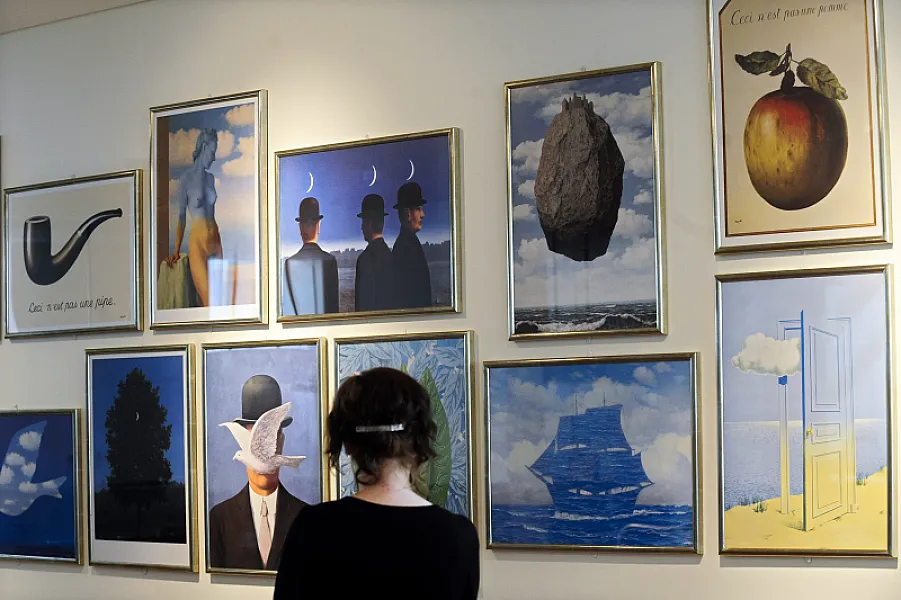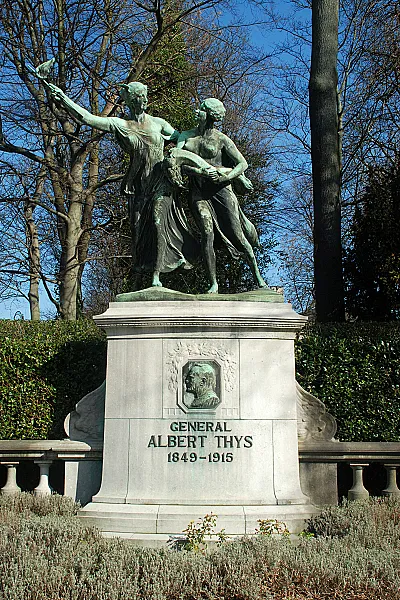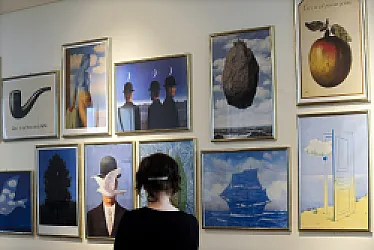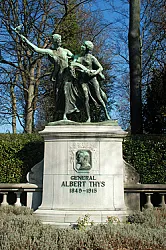Visit Brussels in 2 days
12 must-see POIs, optimized routes and anecdotes.
POIs
12
Distance
5.3 km
Duration
8h15
Loading map...
Day 1
Day 2
You will visit the most beautiful points of interest in Brussels
Day 1 - Brussels
6 POIs to discoverDay 1 - Morning à Brussels
3 Points of interest - Duration : 3h00 - Distance : 0.3 km - Walking : 0h03
01

Magritte Museum
- The Magritte Museum is a neo-classical building on Brussels' Place Royale.
- The building has been transformed into a hotel, jewelry store and then museum over the centuries.
- The museum houses the world's largest collection of Magritte's works, comprising over 150 pieces.
- The museum's itinerary offers a chronological and thematic exploration of Magritte's work.
- A section is dedicated to Magritte's research on repetition and to the great Magrittian images.
Jouez à ce jeu Coddy pour découvrir ce point d'intérêt
02

Centre for Fine Arts of Brussels
Jouez à ce jeu Coddy pour découvrir ce point d'intérêt
03

Musical Instrument Museum
- The MIM is one of the world's leading musical instrument museums.
- Founded in 1877, the museum boasts over 8,000 instruments, of which more than 1,200 are on display.
- The museum is home to exceptional instruments, such as the luteal invented by Georges Cloetens and the Componium by Winkel.
- In addition to the permanent exhibition, the museum offers temporary exhibitions, concerts and educational activities for all audiences.
- The museum's library boasts more than 30,000 works specializing in musicology and organology.
- The building, considered one of Brussels' Art Nouveau gems, was built in 1899 to plans by architect Paul Saintenoy. .
Jouez à ce jeu Coddy pour découvrir ce point d'intérêt
Day 1 - Afternoon à Brussels
3 Points of interest - Duration : 1h45 - Distance : 4.1 km - Walking : 0h54
01

Pharmacy Delacre
- The former Delacre pharmacy, built in 1898, is now an art gallery with magnificent interior architecture.
- The first floor also houses a cocktail bar reminiscent of the former pharmacy's novel décor.
- Charles Delacre, a pharmacist by training, started selling chocolate in 1870 and opened a dedicated store right next to his pharmacy.
- Two years later, the first Delacre factory was opened.
- In 1879, Delacre became the "Supplier to the Court" and in 1891, it marketed its first cookie, the Pacha Delacre.
- Delacre is now the second largest cookie manufacturer in Europe, 120 years after its beginnings.
- Paul Saintenoy, the architect of the former Delacre pharmacy, also designed the Old England (a little further up the same street), which now houses the Musical Instruments Museum.
- The art gallery greatly respects the interior architecture of the former Delacre pharmacy, offering visitors the chance to admire its woodwork and splendid raised floor.
- Charles Delacre was well surrounded, with famous musicians such as Mathieu Boogaerts, Bertrand Belin, Albin de la Simone and Mina Tindle recording their songs here..
Jouez à ce jeu Coddy pour découvrir ce point d'intérêt
02

Grand Hospice Square
- The Hospice Pachéco, formerly known as the Grand Hospice, is a monumental building constructed between 1824 and 1827.
- Around the hospice, new neoclassical streets and houses were built, giving the neighborhood a unique homogeneity.
- Hospice residents were once divided according to gender and physical ability.
- Today, its garden of 16,000m² is a major heritage site, two of whose gardens are listed.
- It is a center for mediation, hospitality and social innovation.
Jouez à ce jeu Coddy pour découvrir ce point d'intérêt
03

Monument au Général Thys
- The Monument to General Thys is a commemorative structure that celebrates General Albert Thys, a colonizer of Congo.
- Conceived by sculptor Thomas Vinçotte and realized by Frans Huygelen, the monument was inaugurated in 1926, after Vinçotte's death in 1925.
- The monument is a tribute to Thys's work as Leopold II of Belgium's aide in colonial ventures.
- The monument has been listed as a historical monument since November 18, 1976.
- It consists of a bronze group representing the Belgian Genius guiding Congo, symbolized by a young black woman carrying a cornucopia, symbol of the riches of Congo.
- The stone pedestal supporting the bronze group is adorned with a medallion featuring a profile portrait of the General, surrounded by garlands of laurel and oak, emblematic of merit, and topped with a discreet pearl frieze and winged wheels, symbolizing the general's role in promoting railway in Congo.
Jouez à ce jeu Coddy pour découvrir ce point d'intérêt
Day 2 - Brussels
6 POIs to discoverDay 2 - Morning à Brussels
3 Points of interest - Duration : 1h45 - Distance : 0.6 km - Walking : 0h07
01

Manneken Pis
- "The little man [who] pisses", in Brussels dialect, is a 55cm bronze fountain depicting a naked little boy urinating and is the most well-known symbol of the people of Brussels, it also personifies their sense of humor (the zwanze in Brussels dialect) and theirindependence of spirit.
- The earliest mention of the existence of Manneken-Pis dates back to 1451, although the statue has been stolen, damaged, brought back, found, renovated dozens of times since then.
- Although an essential visit for tourists visiting Brussels, in 2012 the statue was voted "Europe's most disappointing curiosity".
- The obscurity surrounding its origins has given rise to many legends: One tells of a child who, in his own way, extinguished the fuse of a bomb with which the enemies of Brussels wanted to set fire to the city.
- Yet another claims that a lost child was found by his father, a wealthy bourgeois from Brussels, in the position one imagines. Nowadays, it is regularly costumed according to various themes and of all nationalities: gala, military, student, folk, associative, musician, sportsman, famous, legendary or real characters costumes...
- The wardrobe, which numbers 1000 costumes as of 2018, is kept at the museum "Maison du Roi" on the Grand-Place.
Jouez à ce jeu Coddy pour découvrir ce point d'intérêt
02

The Flight
- Jacques Brel was a multitalented Belgian artist: singer-songwriter, poet, actor and film director Over 25 million albums sold worldwide Iconic songs: "Ne me quitte pas", "Amsterdam", "Quand on n'a que l'amour", "La Valse à mille temps" Film career: actor and director of several films, including "Franz" and "Le Far West" International influence: his songs inspired many English-speaking artists, such as David Bowie and Leonard Cohen Key dates: born April 8, 1929 in Schaerbeek, Belgium, died October 9, 1978 in Bobigny, France Icon of French chanson, considered one of the greatest singer-songwriters.
Jouez à ce jeu Coddy pour découvrir ce point d'intérêt
03

Fontainas Square
- � The square is named after André-Napoléon Fontainas, former burgomaster of Brussels.
- It occupies the site of the Petite Ile, formed by two arms of the Senne.
- It is part of the central boulevards laid out in 1867-1871 by architect Léon-Pierre Suys.
- Suys planned to erect a monumental fountain here in his 1865 project.
- On the east side of the square, some houses retain their café canopies, such as the Moeder Lambic Beer Bar.
Day 2 - Afternoon à Brussels
3 Points of interest - Duration : 1h45 - Distance : 0.3 km - Walking : 0h04
01

Monument Gabrielle Petit
- Gabrielle Petit was a Belgian nurse and resistance fighter during the First World War. She joined the Belgian Red Cross as a nurse after the German invasion in 1914.
- She worked as a spy for the Allies, gathering and passing on information about enemy troop movements.
- She was arrested and interrogated by the German secret police on several occasions.
- She was sentenced to death and shot on April 1, 1916.
- A state funeral was held in her memory in May 1919.
- At her execution, she pronounced: "Long live the King!
- Vive la..." but did not have time to complete her sentence.
- Several monuments and places bear her name in Brussels and Tournai, where she was born.
Jouez à ce jeu Coddy pour découvrir ce point d'intérêt
02

Brussels Town Hall
- Gothic and classical-style building located on the Grand-Place, opposite the "Maison du Roi".It constitutes the only medieval vestige of the Grand-Place and is made up of two stylistically very different parts :the Gothic-style town hall built in the XVe century along the Grand-Place. a classical-style extension built in the XVIIIth century, consisting of three wings arranged in a U-shape to the rear of the Gothic building.
- The ornamental tower spire is topped by the statue of St.
- Michael, slaying the dragon.
- This is where kings, queens, princes and princesses are civilly married, waving to the crowd from the balcony.
Jouez à ce jeu Coddy pour découvrir ce point d'intérêt
03

House of the Dukes of Brabant
- The House of the Dukes of Brabant is a collection of seven classic Baroque houses The houses bear names such as "La Renommée", "La Fortune" and "La Bourse".
- The houses were destroyed during the bombardment of Brussels in 1695 and rebuilt to plans by architect Guillaume de Bruyn.
- Craft guilds were housed in the House of the Dukes of Brabant until the guilds were abolished during the French Revolution The "House" is adorned at the base of the pilasters with 19 busts of Dukes of Brabant and other rulers of this country, including: Jean IV de Brabant, Philippe de Brabant, Charles le Téméraire, Marie de Bourgogne, Charles Quint, Philippe roi d'Espagne.
Jouez à ce jeu Coddy pour découvrir ce point d'intérêt
Want more adventure?
Discover our urban escape games to transform your visit into an interactive adventure!





































